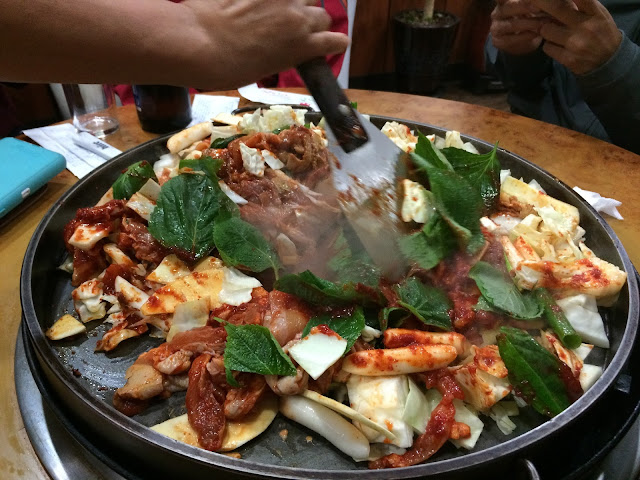The popular Korean dish, dak galbi, begins with the lighting of the propane tank. My friends and I circle around a knee-high table and watch as our server reaches below us to light the heating source while simultaneously placing a giant circular skillet on top. As the pan heats, the warmth penetrates the cool air, providing comfort to my chilled face. My body, now acclimated to the intense heat of Vietnam, constantly shivers in the crisp fall weather it met in Korea.
Once our pan is hot, our server piles it high with rice noodles, potato pieces, cabbage, spinach, chicken, and garlic. It is cooked right there in front of us; the steam heavy and the air becoming thick with the savory scent of chili powder and garlic.
The rapid stirring stops and a mound of grated white cheese is added. The pot is covered for a bit and it all simmers together, the cheese melting into a blanket beneath the metal lid. I notice that with dak galbi, there seems to be no attention to detail; it is quite simply: dump, stir, stir again, simmer.
As we wait, we sip on cold Cass beers and nibble on kimchi. We talk about our international travels and because we are all teachers, we talk about that too.
And then it is ready. We use chopsticks to eat straight from the pan. My mouth becomes hot, both from the temperature and the chili spice. It is delicious. And the sauce is thick; it lingers in my mouth, coating my palate red chili and grease.
When we finish, the pan is reheated and bap, rice, with dried seaweed and a salty red sauce is added. All the leftover pieces and sauce is mixed up with the rice and heated thoroughly. This takes only moments, and although completely full, I manage to consume an entire bowl.
I have never been much of a foodie, but I will say that Korean food alone makes the country worthy of a visit.





No comments:
Post a Comment